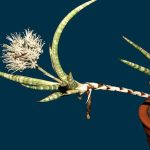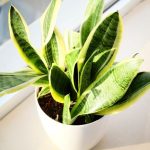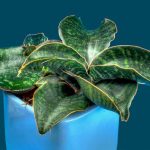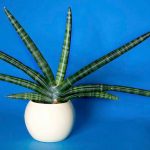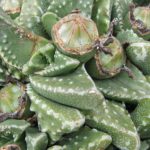Embark on a journey with the remarkable Sansevieria parva, also known as Kenya Hyacinth, an intriguing relative of the snake plant that will make a splendid addition to your plant family.
Quick Care Guide


| Common Name | Kenya Hyacinth |
| Scientific Name | Sansevieria parva |
| Family | Asparagaceae |
| Height & Spread | 12-20″ tall, 8-36″ wide |
| Light | Bright indirect |
| Soil | Well-draining cactus mix |
| Water | Water deeply but infrequently |
| Pests & Diseases | Root rot |
All About Sansevieria Parva
Step into the world of the Kenya Hyacinth, a beloved succulent species suitable for containers or outdoor landscapes. Don’t be fooled, it’s often mistaken for Sansevieria dooneri even by seasoned gardeners!
Unveiled by botanist Nicholas Edward Brown, Sansevieria parva showcases remarkable features like its reflexing medium green leaves and orange rhizomes, resembling Sansevieria dooneri in many ways.
With its thick leaves adorned with dark green cross bands, Sansevieria parva emerges from sturdy rosettes, extending long pendant runners known as stolons that culminate in miniature plantlets, presenting an ideal choice for hanging baskets.
Delicate pale pink to white flowers, exuding a pleasant hyacinth fragrance at night, grace this plant. Originating from East Africa, particularly Madagascar, Kenya, and Burundi, this flowering gem also thrives in South Asia.
Sansevieria Parva Care
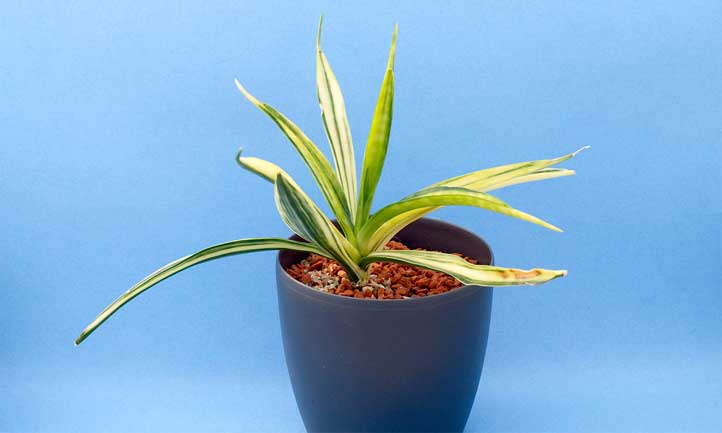

Light & Temperature
Embrace the adaptability of Sansevieria parva, thriving in varying light conditions but thriving best in moderately bright, indirect light. Position it close to a north-facing or sunny window with a sheer curtain for optimum growth.
While tolerant of shade, ample light enhances leaf colors; avoid excessive shade to prevent elongation and yellowing of the leaves. Maintain temperatures between 70 to 90 °F (21 to 32 °C) for optimal growth, as temperatures below 50 °F (10 °C) can impede plant health.
Water & Humidity
Exercise restraint in watering Sansevierias as they detest excessive moisture, which can lead to root rot. Opt for moderate to low humidity environments and water only when the soil is completely dry.
When watering, ensure water drains through, preventing waterlogging. During winter, reduce watering to accommodate the plant’s dormant phase.
Soil
Provide Sansevieria parva with a well-draining succulent mix or a light potting soil supplemented with perlite to mimic its native soil conditions. Aim for a slightly acidic to neutral pH level and avoid moisture-retaining soil.
Emulate the plant’s Eastern African habitat by ensuring a soil mix that promotes efficient drainage.
Fertilizing Sansevieria Parva
When fertilizing this resilient species, adhere to a minimal feeding schedule to prevent leaf damage. Consider a diluted succulent fertilizer every three weeks during the flowering season, avoiding fertilization in winter to align with the plant’s natural rhythm.
Repotting Sansevieria Parva
To prevent the plant from becoming rootbound, it is advisable to repot Sansevieria Parva every 2-3 years. The tall foliage can make the pot top-heavy, so opt for a wide but shallow container, similar to repotting a snake plant.
Sansevieria Parva Propagation
When propagating Sansevieria Parva, it’s best to avoid using seeds from its fine-textured flowers. Instead, opt for leaf cuttings. The 0.5 to 1-inch wide leaves will readily root in well-draining soil, with warmth and bright filtered light. Ensure to water lightly and fertilize during propagation. When the leaves stand erect with a V shape, they are well-rooted and can be transferred to a larger pot.
Pruning Sansevieria Parva
Pruning Sansevieria Parva is mainly done for cosmetic purposes to maintain a bushier appearance and enhance its visual appeal. You can prune dead leaves or overgrown stems, and healthy leaf cuttings can be used for propagation.
Troubleshooting
Growing Problems
To avoid cold damage, maintain temperatures above 50 °F and ensure that the water used for irrigation is not too cold. Cold-stressed leaves develop whitish spots before falling off. Look for medium green leaves that are slightly reflexing as a sign of healthy growth.
Pests
Combat common pests such as vine weevils, grubs, mealybugs, and spider mites with proper pest management techniques. Use beneficial nematodes for weevils and grubs, while neem oil or insecticidal soap can deter mealybugs and spider mites.
Diseases
Prevent fungal infections, which often result in root rot, by avoiding overwatering. If you notice rotting or mushy leaves, remove them and refrain from watering. Repot the Sansevieria Parva in fresh soil if the issue persists, maintaining sparse watering and close monitoring.
Frequently Asked Questions
Q. Is Kenya Hyacinth a flowering plant?
A: Yes, Kenya Hyacinth is a flowering plant that typically blooms from late winter to late spring.
Q: Does Sansevieria like to be crowded?
A: While Sansevieria Parva appreciates some crowding, it can be divided if it becomes too crowded in its pot.
Q: Are Sansevieria hard to take care of?
A: Sansevieria Parva Kenya Hyacinth is easy to care for, thriving in hanging baskets and small planters as long as it’s not overwatered.
Q: How often should a Sansevieria be watered?
A: Water the Sansevieria Parva Kenya Hyacinth only when the soil is completely dry.
Q: Should I put rocks under my snake plant?
A: Incorporating rocks into the soil, rather than under the plant, can aid in drainage for the Sansevieria Parva Kenya Hyacinth.

